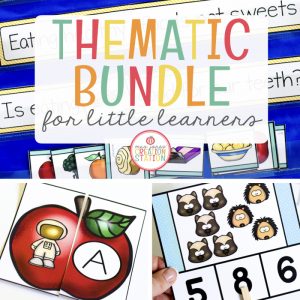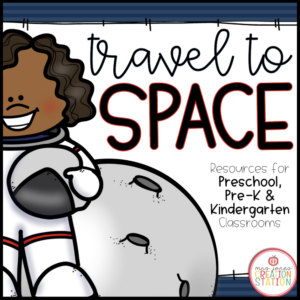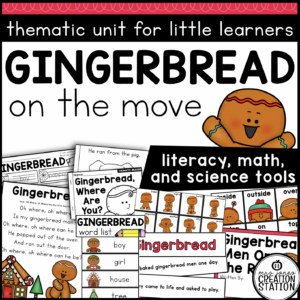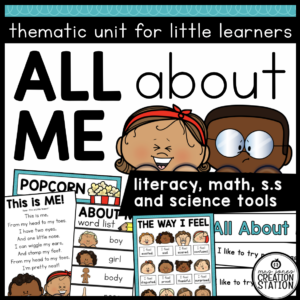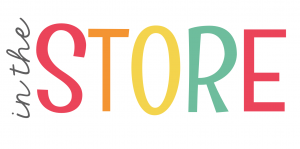Animals in Winter
Find out what animals do in the winter with these fun, engaging activities! This science based unit ties science, math and literacy together and provides you with tons of activities for an entire week of instruction!
Use the detailed lesson plans to guide you through five days of winter animals lessons and activities. A list of preferred picture books is included to tie in with each activity. Activities cover winter animal facts, hibernation, migration and adaptations.
Add the winter animals themed literacy and math centers to your plans to guarantee student engagement while you’re teaching in small groups.
Buy the BUNDLE and SAVE! You can purchase this resources in the Thematic Activities for Little Learners Bundle and the Little Learners Mega-Bundle!
Here is what you’ll get:
-Detailed lesson plans
-A list of picture books to use during your whole group lessons (books not included)
-Shared writing and reading activities
-Writing center activities
-Winter Animals themed interactive poem
-Five days of winter animals whole group activities
-Winter animals themed literacy and math centers
**To see this resource in more detail, check out this resource’s preview!
⭐⭐⭐⭐⭐ What Teachers Are Saying:
“We enjoyed these activities during our Animals in Winter Theme! The activities are easy to implement with any level of student in the classroom!” -Teresa N.
“This is the BEST resource I have used to teach my littles about Winter animals. They loved tis resource and were so engaged!” -Marisa Y.
“This unit is so fun for young learners! Love the introduction to hibernation, migration and adaptions. My children are loving all the activities and poems! ” -Nikki N.
YOU MIGHT ALSO LIKE
WINTER THEMATIC UNIT
POLAR ANIMALS THEMATIC UNIT
PENGUIN SCIENCE LAPBOOK
LEARNING STANDARDS INCLUDED IN THIS RESOURCE
Common Core Standards
Language Arts
CCSSL.K.1a
Print many upper- and lowercase letters.
CCSSL.K.2c
Write a letter or letters for most consonant and short-vowel sounds (phonemes).
CCSSL.K.6
Use words and phrases acquired through conversations, reading and being read to, and responding to texts.
CCSSRF.K.1d
Recognize and name all upper- and lowercase letters of the alphabet.
CCSSRF.K.2b
Count, pronounce, blend, and segment syllables in spoken words.
Isolate and pronounce the initial, medial vowel, and final sounds (phonemes) in three-phoneme (consonant-vowel-consonant, or CVC) words. (This does not include CVCs ending with /l/, /r/, or /x/.)
CCSSL.K.5a
Sort common objects into categories (e.g., shapes, foods) to gain a sense of the concepts the categories represent.
CCSSRI.K.1
With prompting and support, ask and answer questions about key details in a text.
CCSSRI.K.7
With prompting and support, describe the relationship between illustrations and the text in which they appear (e.g., what person, place, thing, or idea in the text an illustration depicts).
With prompting and support, ask and answer questions about key details in a text
Math
CCSSK.CC.A.2
Count forward beginning from a given number within the known sequence (instead of having to begin at 1).
CCSSK.CC.A.3
Write numbers from 0 to 20. Represent a number of objects with a written numeral 0-20 (with 0 representing a count of no objects).
CCSSK.CC.B.4
Understand the relationship between numbers and quantities; connect counting to cardinality.
CCSSK.CC.B.4b
Understand that the last number name said tells the number of objects counted. The number of objects is the same regardless of their arrangement or the order in which they were counted.
CCSSK.CC.B.5
Count to answer “how many?” questions about as many as 20 things arranged in a line, a rectangular array, or a circle, or as many as 10 things in a scattered configuration; given a number from 1-20, count out that many objects.
CCSSK.G.A.1
Describe objects in the environment using names of shapes, and describe the relative positions of these objects using terms such as above, below, beside, in front of, behind, and next to.
Next Generation Science Standards
NGSSK-ESS3-1
Use a model to represent the relationship between the needs of different plants or animals (including humans) and the places they live. Examples of relationships could include that deer eat buds and leaves, therefore, they usually live in forested areas; and, grasses need sunlight so they often grow in meadows. Plants, animals, and their surroundings make up a system.
NGSSK-ESS2-2
Construct an argument supported by evidence for how plants and animals (including humans) can change the environment to meet their needs. Examples of plants and animals changing their environment could include a squirrel digs in the ground to hide its food and tree roots can break concrete.
NGSSK-LS1-1
Use observations to describe patterns of what plants and animals (including humans) need to survive. Examples of patterns could include that animals need to take in food but plants do not; the different kinds of food needed by different types of animals; the requirement of plants to have light; and, that all living things need water.
Texas Essential of Knowledge and Skills
Language Arts
TEKSLA.K.2.A.iv
Developing and sustaining foundational language skills: listening, speaking, reading, writing, and thinking–beginning reading and writing…The student expects to: demonstrate phonological awareness by: identifying syllables in spoken words.
TEKSLA.K.2.A.vi
Developing and sustaining foundational language skills: listening, speaking, reading, writing, and thinking–beginning reading and writing…The student expects to: demonstrate phonological awareness by: segmenting multisyllabic words into syllables.
TEKSLA.K.2.A.ix
Developing and sustaining foundational language skills: listening, speaking, reading, writing, and thinking–beginning reading and writing…The student expects to: demonstrate phonological awareness by: manipulating syllables within a multisyllabic word.
TEKSLA.K.2.B.ii
Developing and sustaining foundational language skills: listening, speaking, reading, writing, and thinking–beginning reading and writing…The student expects to: demonstrate and apply phonetic knowledge by: using letter-sound relationships to decode, including VC, CVC, CCVC, and CVCC words.
TEKSLA.K.2.C.i
Developing and sustaining foundational language skills: listening, speaking, reading, writing, and thinking–beginning reading and writing…The student expects to: demonstrate and apply spelling knowledge by: spelling words with VC, CVC, and CCVC.
TEKSLA.K.2.D.v
Developing and sustaining foundational language skills: listening, speaking, reading, writing, and thinking–beginning reading and writing…The student expects to: demonstrate print awareness by: identifying all uppercase and lowercase letters.
TEKSLA.K.5.B
Comprehension skills: listening, speaking, reading, writing, and thinking using multiple texts…The student expects to: generate questions about text before, during, and after reading to deepen understanding and gain information with adult assistance.
Language Arts
TEKSLA.K.5.E
Comprehension skills: listening, speaking, reading, writing, and thinking using multiple texts…The student expects to: make connections to personal experiences, ideas in other texts, and society with adult assistance.
TEKSLA.K.5.H
Comprehension skills: listening, speaking, reading, writing, and thinking using multiple texts…The student expects to: synthesize information to create new understanding with adult assistance.
TEKSLA.K.5.I
Comprehension skills: listening, speaking, reading, writing, and thinking using multiple texts…The student expects to: monitor comprehension and make adjustments such as re-reading, using background knowledge, checking for visual cues, and asking questions when understanding breaks down with adult assistance.
TEKSLA.K.6.B
Response skills: listening, speaking, reading, writing, and thinking using multiple texts. The student responds to an increasingly challenging variety of sources that are read, heard, or viewed. The student expects to: provide an oral, pictorial, or written response to a text.
Math
TEKSMA.K.2.A
Number and operations. The student applies mathematical process standards to understand how to represent and compare whole numbers, the relative position and magnitude of whole numbers, and relationships within the numeration system. The student expects to: count forward and backward to at least 20 with and without objects.
TEKSMA.K.2.B
Number and operations. The student applies mathematical process standards to understand how to represent and compare whole numbers, the relative position and magnitude of whole numbers, and relationships within the numeration system. The student expects to: read, write, and represent whole numbers from 0 to at least 20 with and without objects or pictures.
TEKSMA.K.2.C
Number and operations. The student applies mathematical process standards to understand how to represent and compare whole numbers, the relative position and magnitude of whole numbers, and relationships within the numeration system. The student expects to: count a set of objects up to at least 20 and demonstrate that the last number said tells the number of objects in the set regardless of their arrangement or order;
Science
TEKSSCI.K.2.A
Scientific investigation and reasoning. The student develops abilities to ask questions and seek answers in classroom and outdoor investigations. The student expects to: ask questions about organisms, objects, and events observed in the natural world.
TEKSSCI.K.9.B
Organisms and environments. The student knows that plants and animals have basic needs and depend on the living and nonliving things around them for survival. The student expects to: examine evidence that living organisms have basic needs such as food, water, and shelter for animals and air, water, nutrients, sunlight, and space for plants.
CONNECT WITH MJCS
WEBSITE | FACEBOOK | INSTAGRAM | PINTEREST | TEACHERS PAY TEACHERS
© Mrs. Jones’ Creation Station, Inc
